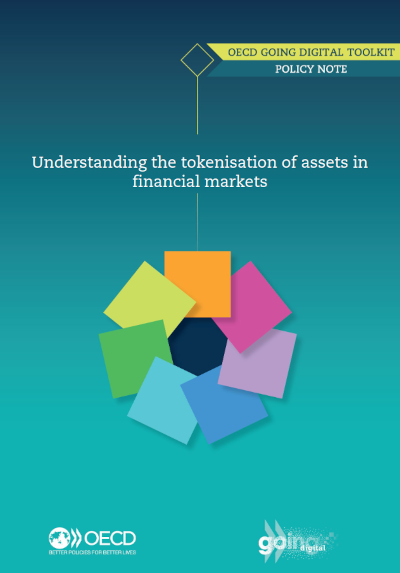Introduction
In the ever-evolving landscape of finance, the emergence of blockchain technology and cryptocurrencies has revolutionized traditional asset management. The tokenisation of assets in financial markets represents a paradigm shift, offering unparalleled opportunities for investors, businesses, and regulators alike.
This blog post delves deep into the OECD report “Understanding the tokenisation of assets in financial markets” on the tokenisation of assets in financial markets, providing a comprehensive overview of key insights and recommendations.
Understanding Tokenisation
Asset tokenisation involves the digital representation of physical assets on distributed ledgers or the issuance of native tokens on the blockchain.
Initially linked to non-compliant initial coin offerings in 2017-18, tokenisation has become a prominent application of distributed ledger technologies in financial markets. This evolution has led to various tokenised asset classes, including securities, commodities, and non-financial assets.
The process of asset tokenisation can be summarized as embedding the economic value and rights of real assets onto DLT-based tokens, creating a store of value. Tokens can exist on the blockchain (‘digital twin’), while the underlying real assets remain off-chain. This approach enables the creation of trading instruments through blockchain issuance, with tokens residing exclusively on the distributed ledger.

The OECD Toolkit note emphasizes the significance of tokenised assets within financial markets, focusing on financial products and excluding utility tokens or similar forms. Regulatory approaches to central bank digital currencies are not discussed in this context.
Benefits of Tokenisation
The application of Distributed Ledger Technologies (DLTs) and smart contracts in asset tokenisation offers various benefits, including efficiency gains through automation and disintermediation, transparency, improved liquidity potential, enhanced tradability of traditionally illiquid assets, and faster clearing and settlement processes post-trade.
Asset tokenisation can enable fractional ownership of assets, reducing investment barriers and providing more inclusive access for retail investors to previously unattainable asset classes. Moreover, it can facilitate private financing from capital owners to small and medium-sized enterprises (SMEs), enhancing SMEs’ access to funding.
However, the adoption of DLTs in tokenised markets also presents risks and challenges due to the novel business models and processes involved, as well as the innovative nature of the technology. Operational vulnerabilities such as scalability issues, settlement finality uncertainties, interoperability challenges between different networks, network stability, market infrastructure robustness, and cyber threats are notable concerns.
Governance risks arise from the decentralized nature of ledgers, making it difficult to identify a single accountable entity for the network, which poses challenges for regulation and accountability in case of network failures.
Additionally, legal uncertainties surrounding smart contracts, auditability of smart contract code, data protection, privacy issues, and risks related to anti-money laundering and counter-terrorism financing are significant considerations in DLT-based systems and tokenised markets.
Regulatory Considerations
Tokenised assets within the oversight of financial market regulators must adhere to regulatory requirements that promote financial stability, consumer protection, market integrity, and competition. Policymakers worldwide have approached tokenisation differently based on the market’s development stage, pace of evolution, financial architecture, the number of involved policymakers, and domestic FinTech strategies.
Some blockchain-based products intersect with payments, regulated securities markets, and financial market infrastructures, necessitating coordination among national authorities. Collaboration at the international level is crucial due to the global nature of tokenised asset markets.
Regulatory approaches to tokenisation involve applying existing financial regulations, introducing tailor-made frameworks, or adapting rules to accommodate Distributed Ledger Technologies (DLTs) in tokenisation. Most jurisdictions with active tokenised markets have adopted a technology-neutral approach, applying the same rules to similar activities and risks regardless of the technology used.
Policymakers have provided guidance to address ambiguity for market participants and have developed frameworks to clarify the regulation of tokens or digital assets. Some jurisdictions have implemented bespoke rules for tokenised assets, such as the European Commission’s proposal for Markets in Crypto Assets (MiCA) or Germany’s Electronic Securities Act. Others have adjusted existing frameworks or introduced new roles related to tokenisation. Additionally, some countries have introduced holistic frameworks like ‘Blockchain Acts’ to cover DLT activity in financial markets, promoting regulatory clarity and innovation in the tokenisation space.
Market Infrastructure
The development of robust market infrastructure is essential for the widespread adoption of tokenisation. From digital asset exchanges to secure custody solutions, a well-functioning infrastructure is vital to ensure market integrity and investor confidence. Interoperability between different platforms and standardisation of protocols are critical factors in creating a seamless tokenisation ecosystem.
Challenges and Opportunities
While the tokenisation of assets presents significant opportunities, it also poses challenges that must be addressed. Security vulnerabilities, regulatory uncertainties, and technological limitations are key hurdles that require innovative solutions. By overcoming these challenges, the financial industry can unlock the full potential of tokenisation and drive greater efficiency and inclusivity in asset markets.
Conclusion
In conclusion, the tokenisation of assets in financial markets represents a transformative shift towards a more efficient, transparent, and inclusive financial ecosystem. By embracing blockchain technology and cryptocurrencies, stakeholders can unlock new opportunities for investment, enhance market liquidity, and foster greater trust in the financial system.
Regulatory clarity, robust market infrastructure, and innovative solutions are key pillars in realizing the full potential of tokenisation. As we navigate the complexities of the digital age, collaboration and forward-thinking strategies will pave the way for a future where tokenisation revolutionizes the way we perceive and interact with financial assets.

Leave a Reply